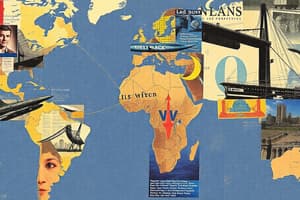Podcast
Questions and Answers
How has globalization made countries more interdependent? Choose five answers.
How has globalization made countries more interdependent? Choose five answers.
- Countries rely on each other for cheaper products. (correct)
- Countries now rely on one another for chances to import and export. (correct)
- Countries now rely on one another for an employment base. (correct)
- Countries now rely on one another for vital resources. (correct)
- Countries now rely on each other for new industries. (correct)
What are the most likely reasons a US corporation would open a factory in China? Choose four answers.
What are the most likely reasons a US corporation would open a factory in China? Choose four answers.
- To take advantage of affordable land prices. (correct)
- To take advantage of lower labor costs. (correct)
- To take advantage of abundant resources. (correct)
- To take advantage of favorable tax laws. (correct)
One way to measure economic growth is by using GDP, which stands for?
One way to measure economic growth is by using GDP, which stands for?
Gross Domestic Product
Recent improvements in ___ have increased the pace of globalization.
Recent improvements in ___ have increased the pace of globalization.
Purchasing power parity is used to compare the gross domestic product between?
Purchasing power parity is used to compare the gross domestic product between?
Based on the map, which is the best conclusion that can be drawn about the economies of the US and Western Europe?
Based on the map, which is the best conclusion that can be drawn about the economies of the US and Western Europe?
How have airplanes changed the way the world does business? Choose four answers.
How have airplanes changed the way the world does business? Choose four answers.
Study Notes
Globalization and Interdependence
- Countries rely on each other for vital resources, fostering economic dependence.
- Collaborative relationships form around new industries, enhancing technological and economic advancements.
- Import and export opportunities promote mutual benefits among nations.
- Cheaper products available through international trade decrease costs for consumers.
- An increased employment base arises as countries depend on each other for labor markets.
Reasons for US Corporations Opening Factories in China
- Affordable land prices in China attract US investments, reducing overhead costs.
- Abundant resources available in China support operations and production.
- Lower labor costs provide significant savings, promoting profit maximization.
- Favorable tax laws in China incentivize foreign corporations to establish manufacturing hubs.
Economic Growth Measurement
- Gross Domestic Product (GDP) serves as a key indicator for assessing a country's economic growth.
Impact of Technology on Globalization
- Technological advancements have accelerated the pace of globalization, facilitating international connections and trade.
Purchasing Power Parity
- Purchasing power parity (PPP) is a method used to compare GDP across different countries, accounting for relative cost of living and inflation rates.
Economic Strength of the US and Western Europe
- High GDP levels indicate strong economies for both the US and Western Europe, reflecting their significant impact on global markets.
Effect of Air Travel on Business
- Air travel has reduced costs associated with long trips, making international business more feasible.
- Shortened travel times enhance the efficiency of business operations and meetings.
- New trade markets emerge as global connectivity improves through air travel.
- Increased options for travel destinations contribute to greater exchange of goods and ideas internationally.
Studying That Suits You
Use AI to generate personalized quizzes and flashcards to suit your learning preferences.
Description
Explore the pivotal role of globalization in shaping economic interdependence among nations. This quiz covers factors influencing US corporations in foreign markets, particularly China, and how GDP measures economic growth. Test your understanding of international trade dynamics and their implications.




